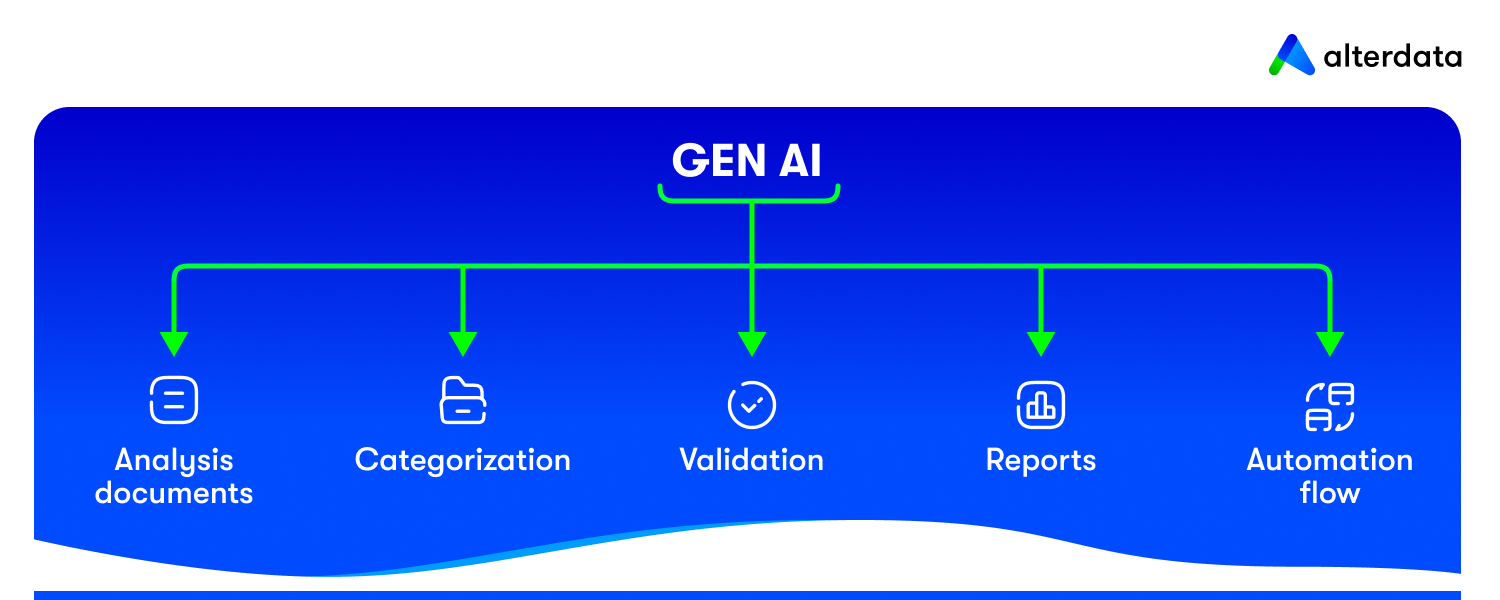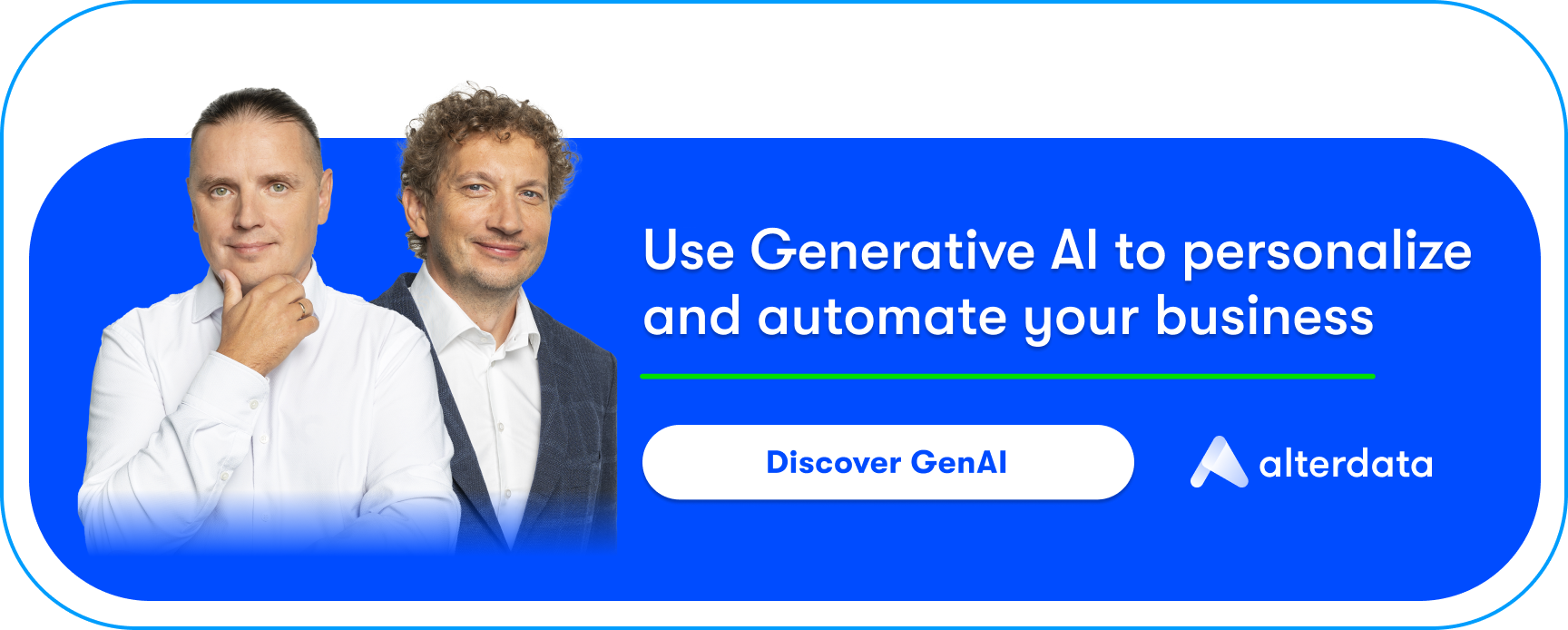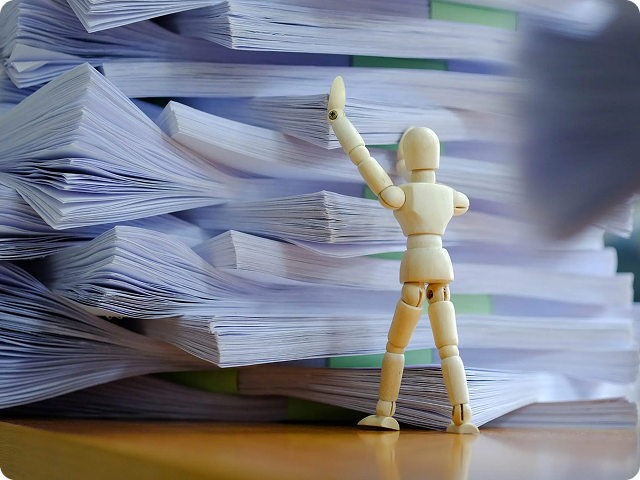Introduction to GenAI in business documentation
Introducing GenAI into business documentation management is a step that can dramatically increase efficiency and the level of automation in business processes. By leveraging artificial intelligence, companies gain not only technical support in creating documents and generating reports but also the ability to continuously monitor and regularly update systems. This helps maintain regulatory compliance and minimize errors that may occur in traditional manual processes, while also automating repetitive tasks alongside automating repetitive activities.
Generative AI enables software to learn the fundamental patterns of a corpus of images, text, and audio files, and then rapidly produce comprehensive results.
The potential of GenAI in business documentation is vast – from streamlining daily tasks and automating repetitive activities to improving the efficiency of entire business processes. Applying AI in this area translates into real benefits: reducing working time, lowering operational costs, and increasing team productivity. Generative AI applications can create high-quality, contextually relevant content in a fraction of the time it takes today, transforming various business functions. Additionally, generative AI can produce vital insights based on specific business data, such as predicting maintenance needs or customer behavior. Large language models and text generation are key technologies enabling these capabilities, allowing for natural language understanding, prompt engineering, and integration with external knowledge sources. Companies that decide to implement GenAI can expect better control over documentation, faster access to key information, and greater flexibility in responding to changing market needs. However, the effectiveness of GenAI depends on access to relevant data and domain-specific data—using appropriate enterprise data is essential for generating comprehensive and accurate insights.
You have documents, not data
Most companies have digital archives that are essentially paper binders in online form. PDFs, scans, files without a unified structure. Finding specific information takes minutes, sometimes hours. Manual document workflows are time-consuming and cause unnecessary delays that automation can eliminate, especially when dealing with many documents. Document automation is not a matter of innovation – it is an operational necessity.
New GenAI tools break the barrier between content and data. Document data extraction is a key capability of automation, enabling the conversion of unstructured documents into actionable data. Below you will find 5 concrete scenarios where you can use GenAI to organize documents, accelerate processes, and improve decision quality.
Document automation is increasingly used in industries that require extensive document review, such as banking, insurance, healthcare, and legal.

1. Data extraction from contracts and administrative decisions using Artificial Intelligence
This is one of the most common use cases for GenAI. Documents such as contracts or administrative decisions contain many key data points: dates, case numbers, locations, financial terms, key terms, contracting parties. The problem is that these data points do not always appear in the same place, are not labeled with headers, and their layout varies by source. GenAI can “read” documents like a human – it understands context, recognizes proper names, can segment sections, extract key information, and extract data even from text written in ambiguous official language. This is particularly useful when processing backlog documents that have accumulated in archives for years.
Thanks to advanced machine learning models, GenAI can analyze diverse document formats and structures, even if they are unstructured or contain errors. This process requires prior training of the model on large volumes of training data, enabling it to recognize patterns and specific information in the text. GenAI helps extract relevant information from documents, streamlining workflows, improving efficiency, and supporting better decision-making. As a result, companies gain the ability to automatically process contracts and administrative decisions, significantly reducing the time needed for manual data entry and minimizing the risk of errors.
Integrating GenAI with existing IT systems provides quick access to extracted data that can be further used in business processes, analyses, or reporting. This enables enterprises to make better and more informed decisions based on current and precise information contained in documents. Best practices for optimizing document data extraction processes include ensuring data quality and integrating with existing systems.
2. Categorizing unstructured documents
In many companies, file names say nothing about their content. Folders are full of files named like “scan_2021.pdf” or “file123_final_ver7.pdf.” Implementing GenAI allows automating the classification of such documents based on their content rather than their name. The model can determine whether a document is a contract, protocol, decision, annex, invoice, or policy document – and assign the appropriate tag or path. Automating invoice categorization enables their quick routing to accounting systems or tax authorities, significantly streamlining invoicing and financial data management processes. Such categorization is the first step towards building order and preparing the ground for further automation, e.g., routing to appropriate systems or departments.
Using advanced natural language processing techniques, GenAI analyzes document content at the semantic level, allowing precise identification of document type even in cases of non-standard formats or heterogeneous structures. The model learns from large datasets of training data, enabling it to recognize patterns and characteristic features of individual document categories. This categorization process helps convert unstructured documents into structured data, making them easier to manage, store, and analyze for business intelligence purposes.
Automating document categorization not only speeds up operational processes but also minimizes human errors often occurring when manually assigning files to appropriate folders or systems. As a result, companies gain better control over their information assets, leading to more efficient documentation management and faster access to needed information.
Implementing GenAI for document classification can be easily integrated with existing document management platforms and tools, increasing the value of the investment and allowing gradual expansion of automation with additional functionalities such as data extraction or report generation. Intelligent Document Processing (IDP) leverages natural language processing (NLP), computer vision, generative AI, and machine learning to turn business documents into process-ready information.
3. Data validation in documents
Errors in documents can be costly. Incorrect contract start dates, wrong decision numbers, or inconsistencies between documents are problems difficult to detect manually at scale. GenAI can act as a validation layer: checking data consistency against patterns, detecting anomalies, and flagging discrepancies. It can also compare documents to assess whether they contain the same data that should be consistent. This is a huge time saver for operational teams and guarantees greater consistency.
By leveraging advanced algorithms and machine learning models, GenAI can analyze vast amounts of documents in a short time, identifying potential errors and inconsistencies that might be overlooked by humans. The system learns from historical data and patterns, continuously improving its validation capabilities. Moreover, GenAI can generate reports with detected issues, enabling quick corrective actions. Automated document processing eliminates errors and protects sensitive data. In practice, this means companies can minimize legal and financial risks resulting from documentation errors while increasing their teams’ work efficiency and increasing efficiency in operational performance. Data validation with GenAI is not only a control tool but also a component supporting quality and security in business processes.

4. Creating metrics and reports based on documents
Data contained in documents can be automatically transformed into reports and metrics. The number of active contracts, obligations expiring in the coming months, cost distribution by location – all can be generated without manual data entry into Excel. GenAI extracts data from documents and structures it for analysis in BI tools (e.g., Looker Studio, Power BI). Financial analysts can benefit from GenAI by quickly extracting and analyzing data from financial documents, streamlining their workflows and supporting faster, more accurate decision-making. Reports are not created once – they can be updated continuously with incoming new documents.
Transaction data from documents can be automatically extracted and used to populate reports and metrics, further automating the creation of legal, financial, or mortgage documents and streamlining related workflows.
This gives companies quick access to up-to-date information, enabling more informed business decisions. Automating this process eliminates errors related to manual data entry and significantly reduces the time needed to prepare analyses, increasing efficiency across business processes. Additionally, integration with various BI platforms allows creating personalized reports tailored to the needs of specific departments or projects.
Such an approach enables monitoring key performance indicators (KPIs) in real time, which is especially important in a dynamically changing business environment. GenAI can also support data visualization, facilitating result interpretation and communication among teams.
In practice, generating metrics and reports with GenAI is a step towards digital transformation of the enterprise, increasing operational efficiency and enabling better resource and risk management. Document automation also leads to time and financial savings due to decreased paper handling and distribution costs.
5. Handling incoming new documents
A GenAI-based system can operate continuously, reacting to new files and new data as they appear. A document is uploaded to the cloud, the model classifies it, extracts data, validates it, and then saves it in the database and archive. The user receives a ready record for daily work. Completed documents, such as purchase orders, can be immediately forwarded to further processes or sent for signature without additional processing. This way, not only the past backlog is processed, but a future-proof process is built: current documents go directly to the right place in the right structure. The system is designed to efficiently handle a large number of documents, ensuring scalability for organizations dealing with extensive datasets.
Such a continuous document handling process significantly improves the work of teams that deal daily with large volumes of data and information. Automation eliminating the need for manual data entry and document sorting reduces error risk and allows faster response to emerging business needs. Moreover, through integration with other systems, such as document management platforms or analytical tools, extracted data can be used for further analyses, reports, or decision-making processes.
Implementing such a solution requires proper IT infrastructure preparation and staff training to fully leverage GenAI’s potential. However, the benefits brought by automating document inflow quickly translate into time savings, reduced operational costs, and improved work quality. As a result, the organization gains flexibility and readiness to adapt quickly to changing market demands and legal regulations.
Document automation is widely applied across industries: in finance, it streamlines the processing of contracts, purchase orders, and invoices; in healthcare, it supports claims processing and patient onboarding; in logistics, it automates bills of lading, waybills, and packing slips; and in insurance, it enables efficient creation and management of complex policy documents.

AI tools supporting documentation management
Modern AI tools for documentation management have become an indispensable part of daily work in companies aiming to increase efficiency and security of their business processes. They enable automation of tasks such as document creation, report generation, or version control. AI systems analyze document content, support quality control, and ensure data protection and compliance with company policies.
In practice, AI tools act as technical support for teams, facilitating large-scale document management. Document management platforms, report generation applications, and advanced AI systems for archiving and access control not only automate routine activities but also enhance security and transparency of information flow. These tools support advanced analysis such as sentiment analysis, and can recognize and process complex data types, including QR codes, to improve automation and data extraction accuracy. Generative AI can also assist less experienced operators by providing the expertise of experienced operators, effectively bridging the skills gap and improving operational efficiency. This allows companies to focus on key tasks, confident that documentation is organized, up-to-date, and easily accessible when needed. Legal document automation tools provide libraries of legal forms and are designed for generating NDAs, contracts, and legal briefs.
How to implement GenAI in your company?
Implementing GenAI in a company is a process that requires a proactive approach and thorough understanding of organizational needs. The first step is to identify areas where automation and AI support can bring the greatest benefits – for example, in document creation, report generation, or documentation management for a specific task or business problem. Then, it is important to select AI tools that best fit the company’s specifics and business processes. Workflow management in document automation includes managing the document lifecycle, approvals, sending, and tracking.
Equally crucial is training employees to effectively use new solutions and fully exploit GenAI’s potential in daily work. Providing technical support and clearly defining further actions related to monitoring implementation effectiveness and identifying additional automation areas are also important. Regular evaluation of results allows quick response to changes and continuous process improvement.
Thanks to GenAI implementation, companies can expect tangible benefits: increased efficiency, reduced working time, lower operational costs, and better documentation management. This is an investment that quickly pays off and enables the organization to maintain a competitive edge in a rapidly changing market.
What’s next? Summary
Each of these scenarios can be implemented in stages. There is no need to build everything at once. It is enough to start with a specific problem, define data and process, and then iteratively develop the system.
If you want to know how it might look for you, start by preparing your team and data. Implementing GenAI for document work does not begin with choosing a model but with auditing documents, defining business goals, and identifying which data are key for your organization.
At Alterdata, we can help your company through the entire process: from resource analysis, through solution design, to integration with your data environment. Instead of universal templates, we build systems tailored to your problem.
Want to see how it could look for you? Watch the video below or contact us.





























